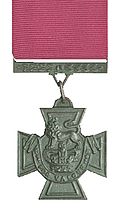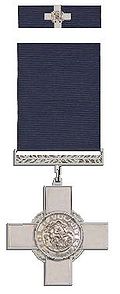

The Victoria Cross and George Cross Association is made up of holders of the Victoria Cross (VC), Britain's highest military award for bravery in the presence of the enemy, and the George Cross (GC), the equivalent award for civilians and also for those military personnel who have displayed conspicuous bravery not in the presence of the enemy.
Contents
- Officers of the VC and GC Association
- Patron
- President
- Vice president
- Chairman
- Secretary
- Chaplain
- See also
- References
- External links
Holders of these awards receive an annuity and attend reunions which receive coverage in the national press. Membership is dwindling for various reasons including the fact that there has not been a "total war" for many years. Canon William Lummis was the chaplain to the Association.
The Victoria Cross and George Cross Association is Headquartered in London at Horse Guards, Whitehall SW1A 2AX, United Kingdom.